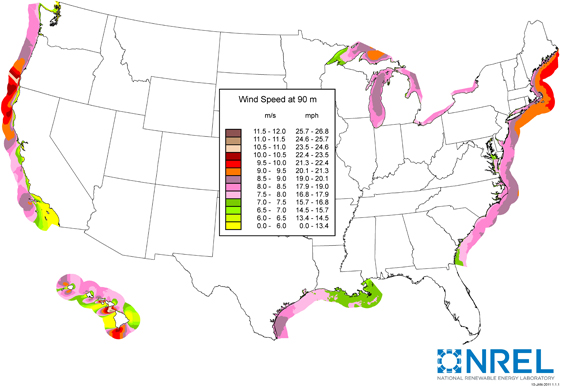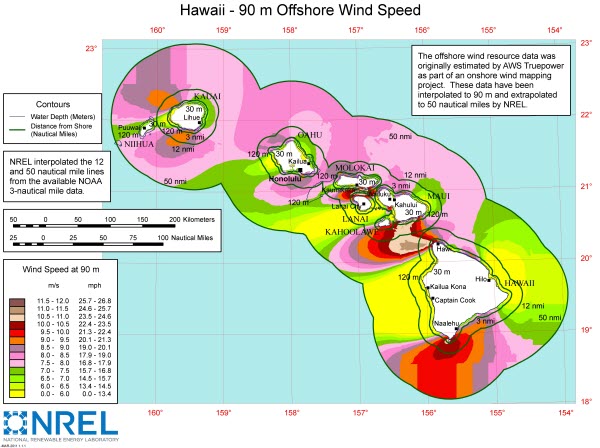
DOE provides detailed offshore wind resource maps
U.S. annual average offshore wind speed at 90 meters

Note: Select a state to view the offshore wind map for that state. The states of Florida, Alabama, and Mississippi did not have any preliminary or final wind maps available due to the lack of tall tower wind measurement data, and offshore wind maps for this region made an estimate of the 90 meter wind speeds problematic.
Wind Powering America (a DOE initiative) publishes a series maps showing the potential to generate electricity from offshore wind resources in the United States. This map complements the map highlighting onshore wind energy potential. These offshore maps show wind speed detail at 90 meters above the water surface (the approximate height of many current-day offshore wind turbines), with a spatial resolution of 200m, for 26 States along the coasts and the Great Lakes. Wind energy potential is broken down by wind speed, water depth, and distance from shore.
The National Renewable Energy Laboratory (NREL) provided an assessment of potential generating capacity from offshore wind, totaling 4,150 gigawatts (GW). At the end of 2009, the Nation's total electric generating capacity was 1,025 GW. The NREL assessment does not consider cost or transmission availability, and assumes all locations meeting certain characteristics will be available for offshore wind development. The development of this assessment evolved over multiple stages as new regional assessments became available, new validation data were obtained, and better modeling capabilities were implemented. It is expected that the current assessment will continue to be periodically updated as additional offshore mapping projects are finished along the Atlantic coast of Florida, the Gulf coast, the Pacific coast, and Alaska.
Offshore winds are attractive as a power source as they are typically both stronger and steadier than winds onshore. Offshore wind turbines, however, are costlier, take longer to build, and are more challenging to maintain. The United States does not currently have any operating, utility-scale offshore wind capacity, although some projects are in the planning stages.
Factors other than wind resource availability, including the future availability of subsidies for wind generation, the cost of natural gas and other competing technologies, and issues surrounding the allocation of costs for transmission projects that could connect wind-rich regions with major load centers, will likely play a dominant role in determining the future use of wind power.
A larger version of the U.S. map and individual State maps are available at the Wind Powering America website; for example, see the detail on Hawaii below:

As described in the previous article about onshore wind energy potential, many factors affect how much wind generating capacity will actually get built. The lack of an offshore electric transmission grid is a significant limiting factor, and siting and cost allocation for transmission are both current issues. Additionally, an overall slowing in electricity demand growth limits the amount of new generating capacity needed. On the other hand, capacity retirements and Renewable Portfolio Standards at the State level work to spur growth in wind capacity.
Tags: electricity, map, offshore, renewables, resources, states, wind